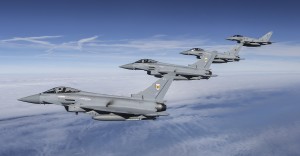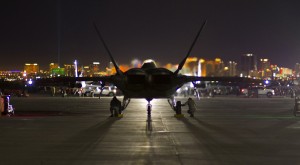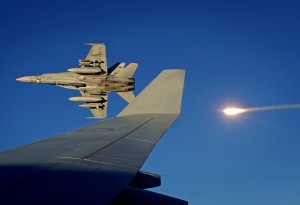2016-08-01 By Robbin Laird
I have had the chance to visit with the pilots and crews of four new or modified new air systems used by the U.S. and the allies in current Middle Eastern operations. Each of these platforms has provided capabilities important to the effort and foreshadows the way ahead.
The F-22 has contributed a new multi-tasking capability; the Operation Shader Typhoons have provided a new ground attack capability for the Eurofighter; the KC-30A has provided significant tanking support as well as re-shaping the con-ops of the tanker; and the Wedgetail has provided a new capability for air battle management in which scanning and tracking can be done simultaneously by the air battle manager.
Discussions with the pilots and crews of each of these new or evolving platforms provided a number of key insights into the evolution of airpower.
For the F-22, the multi-tasking capabilities of the aircraft are being fully flexed in operations. The ability to shift among strike, support, and air battle management tasks has become a key part of the operation. As well, the modernization of the F-22 is expanding its ability to perform its various tasks within a US and coalition environment.
For the Typhoon, the new variants are very capable ground attack aircraft. The RAF refers to these as Operation Shader ready Typhoons, and they are able to fully integrate the Paveway IV within the operations of the aircraft in the battlespace. The Tranche 2 Phase 1 enhancement has seen the integration of Paveway IV into the aircraft; the integration provided a focused capability for the ground strike role.

The software completely changed with an enhanced capability to perform the ground attack role. The pilots can now direct the weapon to a variety of targets with the onboard control systems and software.
JTACS in the Middle East operations are now calling for the Typhoon/Paveway IV capability on a regular basis. The RAF can operate a four-ship formation and strike 16 targets in one pass. The RAF has been able with the modified Typhoons to provide combat mass and significant strike capability, which could be delivered rapidly, and coalition partners quickly began to pick up on this capability.
The Aussies have brought two new aircraft to the fight, namely, the KC-30A and Wedgetail. During my Australian visit I will get updates on both, but it is clear that each provides a significant capability in terms of what a new platform can provide.
Notably, the KC-30A is not just a flying gas can. It does not simply follow the classic tracks system for tanking but flies to where the fighters need to be fueled; it can also find ways to support the combat fleet more flexibly than traditional tankers.
And the operations in the Middle East have laid the groundwork for the next iteration of the tanker in which the RAAF is looking at how to use the space onboard the aircraft for the ISR or C2 capabilities of the air battle management or support functions.
Wedgetail is a very new type of air battle management system, which can both scan and track in the battlespace. This means that the radar tracking signals can be turned on for a short period of time and the information provided to the strike fleet to supplement their own target tracking functions. It is not simply about operating as an air traffic management/battle management system as does the classic AWACS.
It is a software upgradeable aircraft and is in the throes of being prepared to operate with an upgraded architecture which, in turn, will allow it to expand its combat contribution throughout the electronic magnetic spectrum.
But no platform FIGHTS alone, which means that a key part of shaping the way ahead is to find ways to better integrate the force for operations in the extended battlespace.
Indeed, the evolution of new platforms, especially those that are software upgradeable, like the F-35, the P-8 and the Wedgetail, should be shaped on the grounds of their contribution to force packages, not simply on the grounds of what can be upgraded from an organic platform perspective for that platform considered by itself.
As General Hawk Carlisle put it with regard to the challenge:
“Each of the new assets – the F-22, the Typhoon, the Wedgetail and the KC-30A – have performed well. They have proven once again that if you get new assets into the hands of the young men and women in the force that amazing things can happen.
“The platforms have been pushed to a level that we could not guess at prior to real world operations.
“Their performance and that of the entire force is highlighting the need for more effective combat multi-domain integration. That is a key work in progress and these new platforms are driving us further down the road to achieve it.

“We’ll make even more progress when we get to the link architecture and the translators that allow us to truly achieve fifth to fourth and fourth to fifth integration and to take national technical means and bring that into the fight as well.
“What we’re not doing is bringing these disparate parts up together in a collaborative, honeycombed environment at the level that we really can. We’re not off-boarding everything from the F-22 and F-35 that we should. There’s a wealth of information on those platforms that never gets taken advantage of. However, we are working to ensure that we position ourselves to do so.”
A senior U.S. Navy warfighter reinforced Hawk Carlisle’s perspective:
“Hawk clearly speaks to the advantages of the high-end platforms we are fielding, but notes that we are deficient in bringing up our network integration at the same pace.”
Yet understanding this point can be difficult.
The shift is from deploying or upgrading a new platform from an organic platform perspective to one where the upgrades are done with a sense of how best to build force packages to operate in the extended battlespace.
It is about shaping a honeycombed force in which platforms are the key parts in the force package and oriented towards better-integrated operations in the battlespace.
It is not simply about networking the entire force; it is about shaping effective force packages, which can operate more effectively together either in force modules, or a total force package.
A good perspective on the transformation effort was provided by the RAF ISTAR force commander who is focused on the significant challenge of moving for an ISTAR force small f to an ISTAR force big F. The shift has serious implications for how to leverage platforms.

For example, the introduction into service over the next few years of the Poseidon P-8A offers opportunity to bring the previously stove-piped maritime patrol force into the ISTAR fold.
The ISTAR Force Commander, Air Commodore Andrew, sees this as a real test of his transformation leadership – cautioning that if we don’t view the P8-A as a maritime domain awareness strike asset, rather than a replacement MPA, the UK will never realize the full benefit of their investment and generate the enhanced operational effectiveness that is required for the future Joint Force.
As an all software upgradeable fleet replaces the core stove-piped platforms, the possibility could exist to put the platforms in competition with one another for modernization upgrades. Which upgrade gets the priority for which platform to make the greatest contribution to the integrated ISTAR capability are the sort of decisions that should lie with the ISTAR Force in the future – it is at Force level, not within individual programs and projects that the overall capability benefit can be seen and prioritized.
“Making the financial and conceptual space for that enhancement requires a common approach to training, manpower, support and sustainability, information and operating concepts that is at the heart of the transformation. Treating each of the platform types as interconnected segments of an ISTAR capability Venn diagram will allow us to create the breadth of intelligence and understanding in the common operating picture that the Joint Force needs.
“Getting out of the platform stovepipe mentality will not be easy; it will be necessary to shape an overall operational approach to where the key operators of the platforms become plug and play elements in the overall ISTAR Force.”
This is clearly what Carlisle is talking about; and with the contributions of the new or modernized assets like F-22, Typhoon, KC-30A and Wedgetail in mind, how do we get a priority on force package integration at the modular force package level?
And as new assets get introduced like P-8 or F-35, how best to overcome the problem of platform autism?

